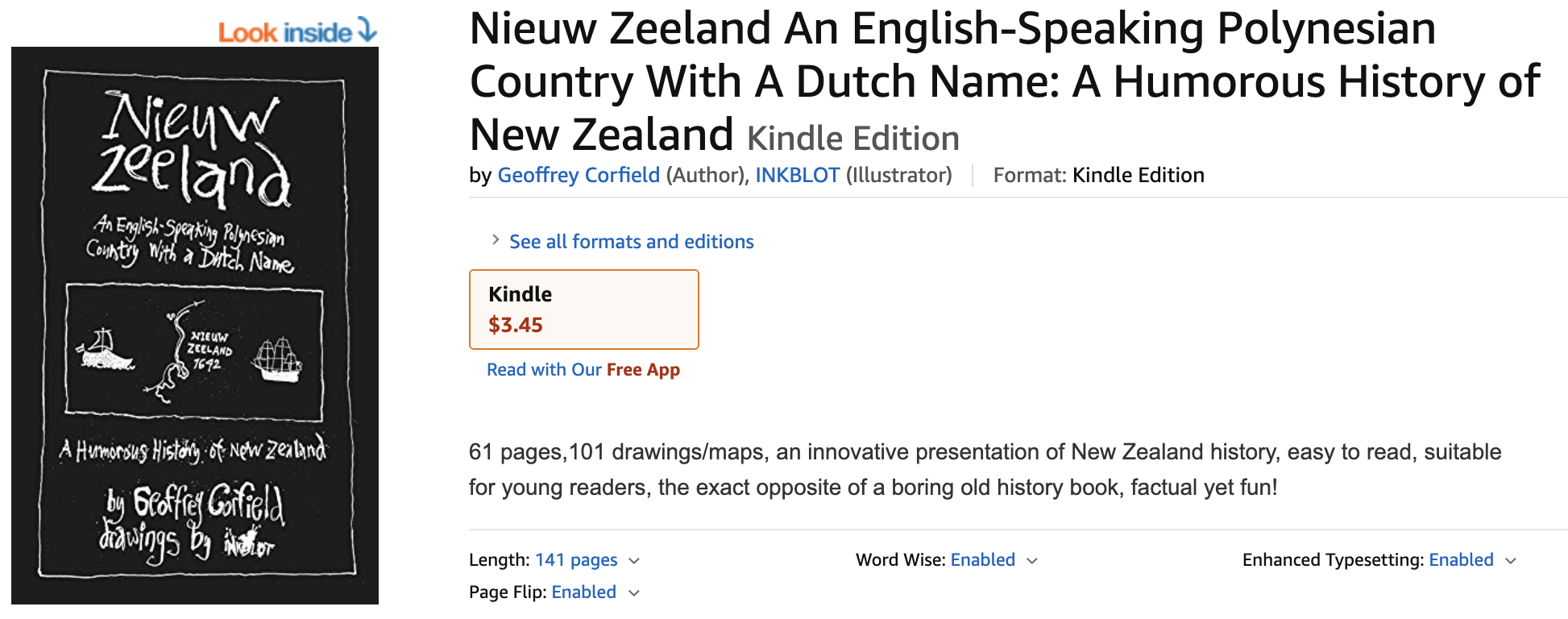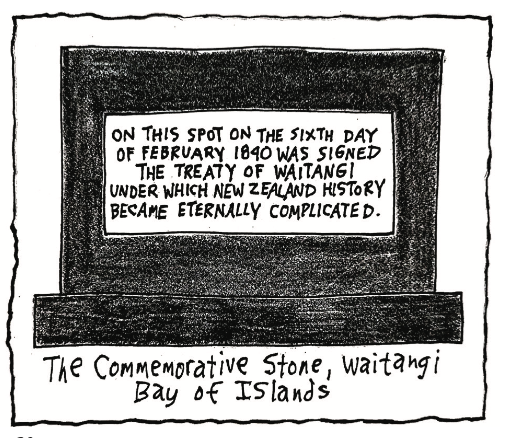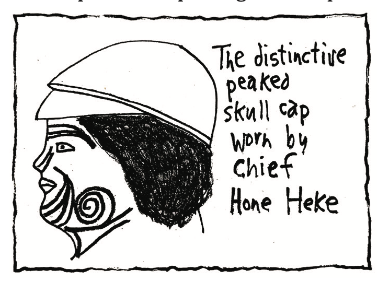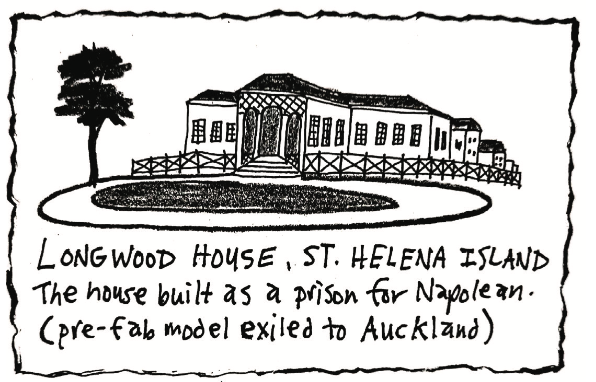Table of Contents
You can purchase Nieuw Zeeland An English-Speaking Polynesian Country With A Dutch Name: A Humorous History of New Zealand by Geoffrey Corfield from Amazon today.

Hobson arrives in Russell on 29 January 1840, and then he too, like Busby, proceeds to do some quite incredible things, and in an incredibly short period of time. The Royal Navy Captain becomes an instant diplomat and bureaucrat.
The next day he proclaims Russell the foundation of a new colony. Five days after arriving he has written out a treaty (with the help of Busby and his 1835 Declaration), had it translated into Maori by the missionaries (completed overnight on 4 February), and had notices printed inviting Maori chiefs to a meeting to be held outside Busby’s house at Waitangi on 5 February 1840, only seven days after he’d arrived. At best he’s allowed two days for the notices to be circulated and the “chiefs” to turn up (of course on a ship that’s plenty of time).

It’s called “The Treaty of Waitangi”. It’s the third order of official government business to be conducted in New Zealand; and it’s one of the most famous (February 6 is Waitangi Day, a public holiday in New Zealand), and one of the most complicated and confusing bits of New Zealand history. After The Treaty of Waitangi, British colonial government is here to stay in New Zealand.

The Treaty of Waitangi, Bay of Islands, 5-6 February 1840
In front of James Busby’s house at Waitangi, tents decorated with flags are arranged around an open space with a platform in the middle. William Hobson sits on the platform. On such incredibly short notice “hundreds” of Maori have attended the meeting and are sitting around the platform, even though no free pot of cold porridge will be provided.
Hobson speaks and then a missionary reads the treaty clause by clause in Maori. The treaty contains a preamble, three articles, and a summary; with a space below for signatures.
Twenty-three “chiefs” speak. The Hokianga Harbour “chiefs” oppose the treaty, and The Bay of Islands “chiefs” support it. The treaty is discussed on 5 February, and on 6 February 46 “chiefs” sign it (26 of whom had also signed the 1835 Declaration). The first chief to sign it is Hone Heke, a relative of Hongi Hika.
On 13 February another 34 “chiefs” sign it, making a total of 88 signatures. By the end of August 1840, there have been some 50 more meetings around the country and a total of some 547 signatures attached to the treaty.
To commemorate the signing Mrs. Busby plants a tree.

Note: It is not known what the status was of all the original 46 “chiefs” who attended and signed, nor of all the signatures on the treaty. Of the first 80 signatures, only seven have since been identified as “chiefs”. Of the 547 total signatures, many have since been identified as: “a descendant of ____”, a younger brother of ____”, “of the ____ Tribe”, “wife of ____”, and “from ____”. Many others have only been identified by name. Three women signed. It has since been observed as well that “The Maori who signed the treaty were only some northern chiefs, and not paramount chiefs, but sub-chiefs”.

On 1 March 1840, Hobson proclaims Auckland the new capital of New Zealand. It has the best harbour in the country, it has been all but deserted by the Maori during the tribal wars, and the price was right (during The Treaty of Waitangi meeting he is offered 3,000 acres in Waitemata Harbour for some gold, clothes, blankets, pots, axes, tobacco, pipes, flour and sugar). Government is moving at lightning speed. Since being in New Zealand for only four weeks and four days, Hobson has signed a treaty and moved the capital (it will never move as fast again).
New South Wales sends Auckland 80 soldiers and eight army officers, 39 civil servants, 11 New South Wales Police troopers, two police magistrates, and a small government budget for a small but speedy government. Britain sends Auckland a prefabricated Government House based on the design of the house built on St. Helena Island for the exiled Napolean (September 1840).

It’s New Zealand’s first government and it consists of: an Executive Council of four (Lieutenant-Governor and three appointed); a Legislative Council of seven (the Executive four and three more appointed); a Lands Claim Commissioner to rule on all land sales before 1840; and a Protector of Aborigines who is also the Land Purchase Officer as the Maori can now only sell land to the Crown. The colony will be funded by monies raised by buying land from the Maori and selling it to settlers.
Hobson deals with the French at Akaroa, and then hears that The New Zealand Company are in Wellington. He declares this treason; proclaims British sovereignty over the North, South and Stewart islands of New Zealand as a dependency of New South Wales; and sends 36 soldiers to Wellington (21 May 1840. Note: Up until 1905 the North Island was called Northern Island, South Island was called Middle Island or Central Island, and Stewart Island was called Stewart’s Island.)
The Lieutenant-Governor is moving fast again. Too fast for some. The settlers and The New Zealand Company don’t like the new land sales policy. The New Zealand Company also doesn’t like the capital not moving to Wellington. The Maori in The Bay of Islands don’t like the capital moving to Auckland. Hone Heke doesn’t like the new government customs duties. He used to collect his own harbour fees, and now with two taxes to pay the ships are not coming to The Bay of Islands anymore.
Britain makes New Zealand a separate colony from New South Wales (1841). Hobson the Lieutenant-Governor is now Hobson the Governor. But it’s too late for Captain William Hobson. He has a stroke, becomes paralysed, and dies in 1842. The pace of government. Poor Hobson. Life was so much simpler in The Royal Navy. New Zealand gets a new Governor.
The New Zealand Company is moving fast too. As well as Wellington, it also establishes colonies in New Plymouth (1841), Wanganui (1841) and Nelson (1842); and has a share in the colonies at Dunedin (1848) and Christchurch (1850). It’s also the beginning of the unrest in New Zealand between the Maori and the British. Before 1840 the Maori thought the British would only be here in small numbers, would bring them trade, and would allow them to remain as they were. But now after 1840 the settlers just keep coming.
In 1840 there are some 2,000 white turnips in New Zealand. By 1860 there are 60,000 of them and they outnumber the Maori for the first time.
Along with the missionaries, The New Zealand Company is responsible for a lot of the interior exploration of the country. Unlike in Australia where the danger to early exploration was a lack of water, in New Zealand it’s the danger of too much water. Drowning in cold, fast-flowing rivers is referred to as “The New Zealand Death”. (“The impulse which impels us to search the wild places of the Earth is good.”)
You can purchase Nieuw Zeeland An English-Speaking Polynesian Country With A Dutch Name: A Humorous History of New Zealand from Amazon today.

If you enjoyed this BFD article please consider sharing it with your friends.








